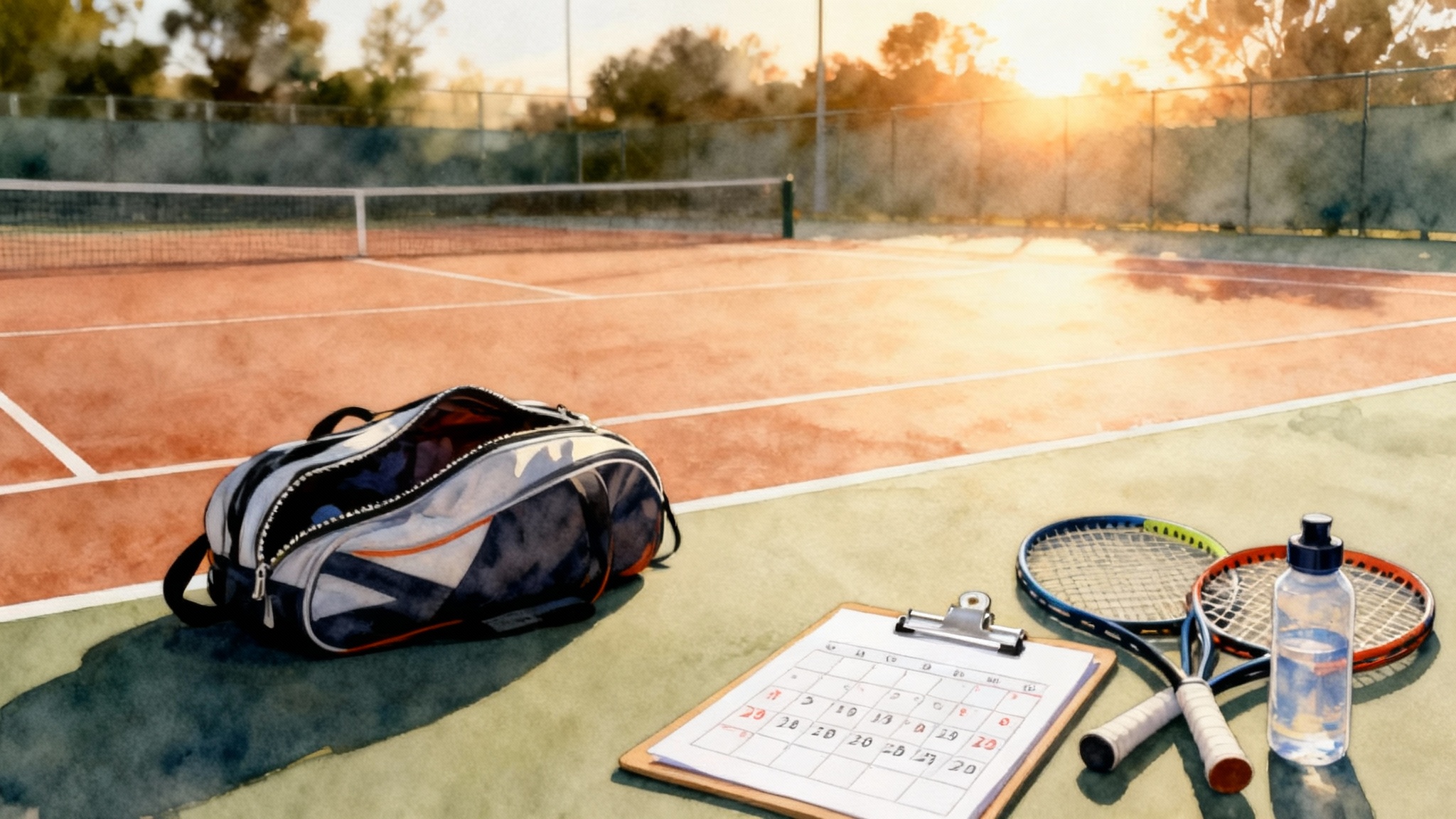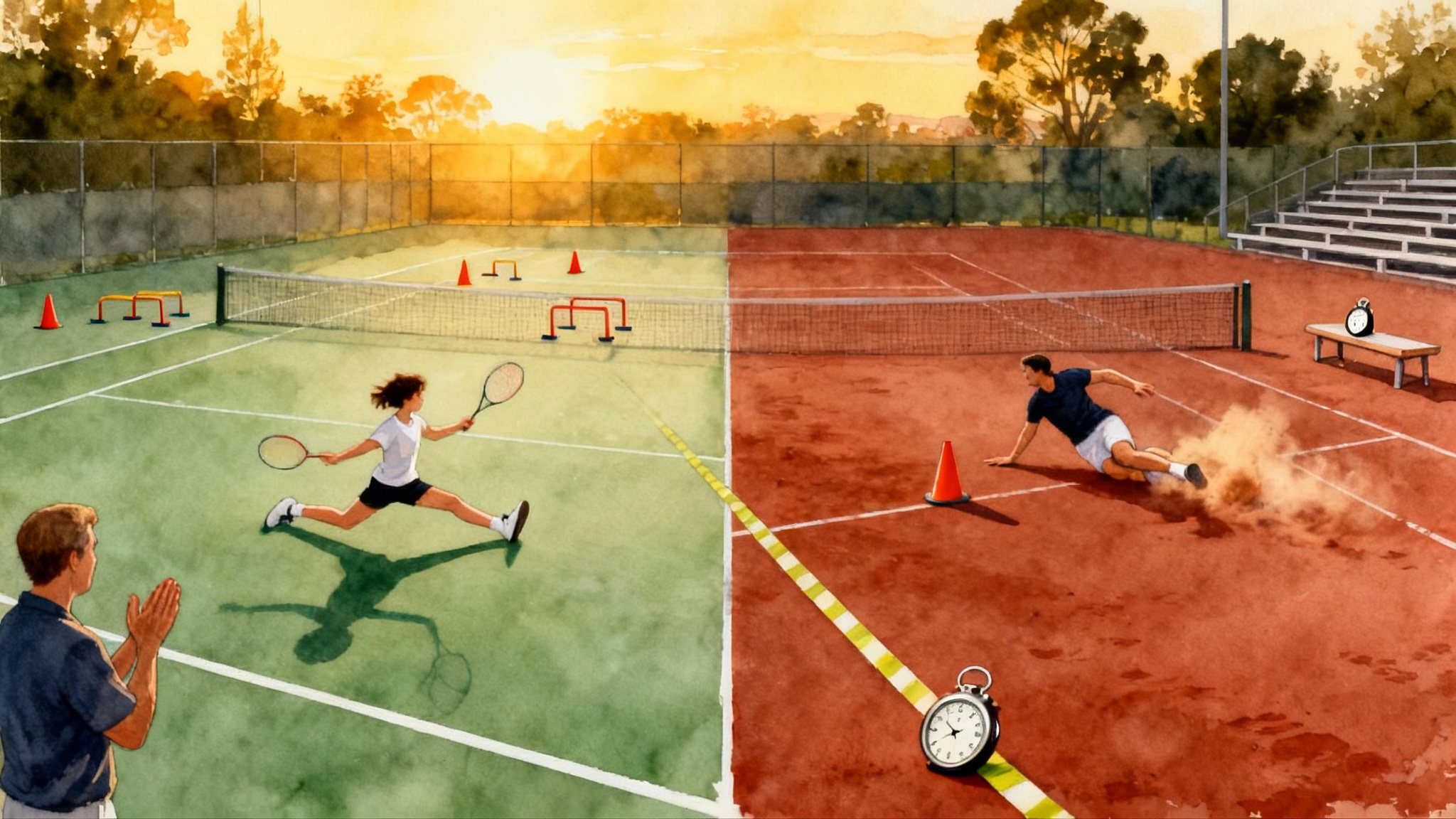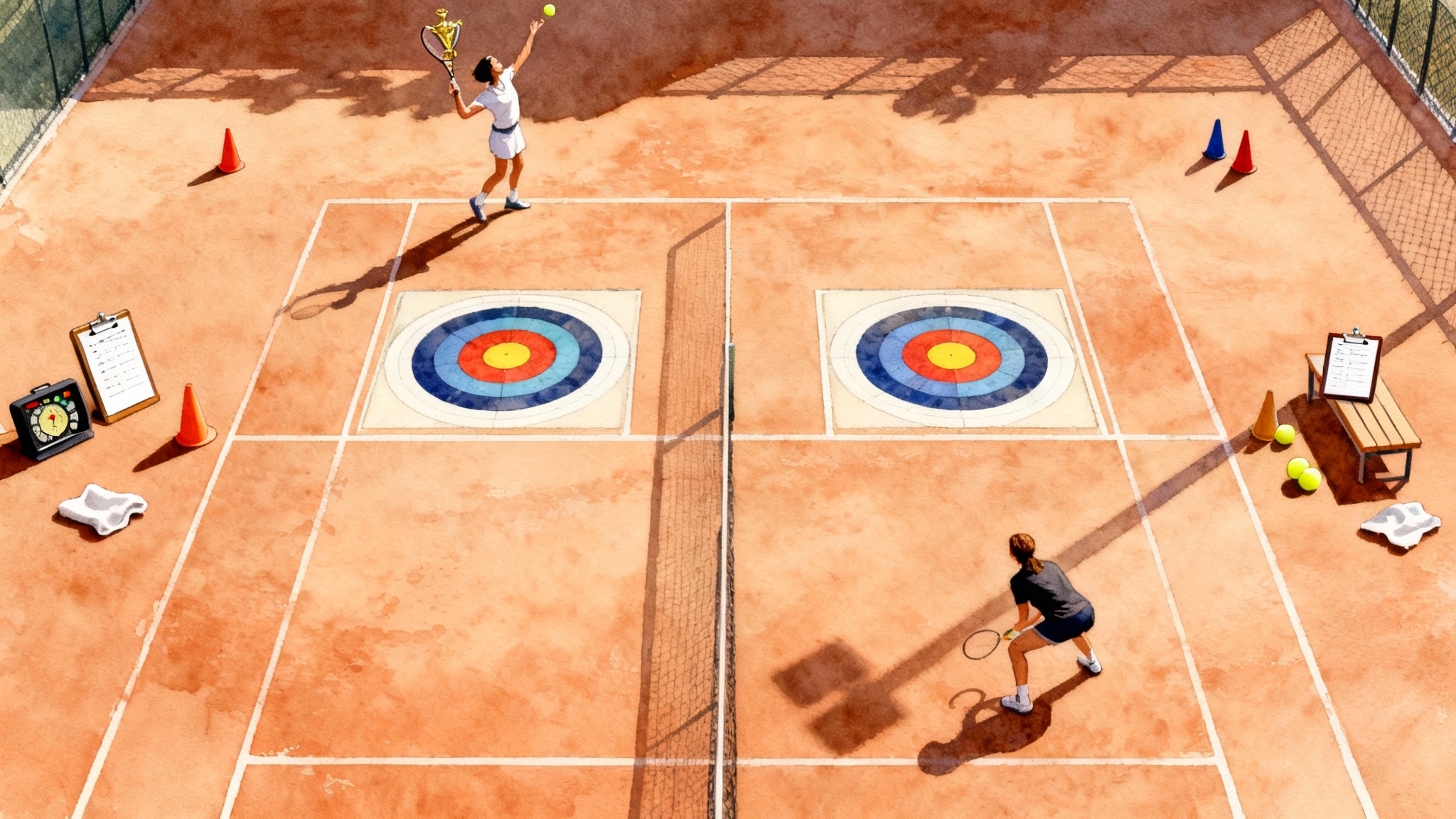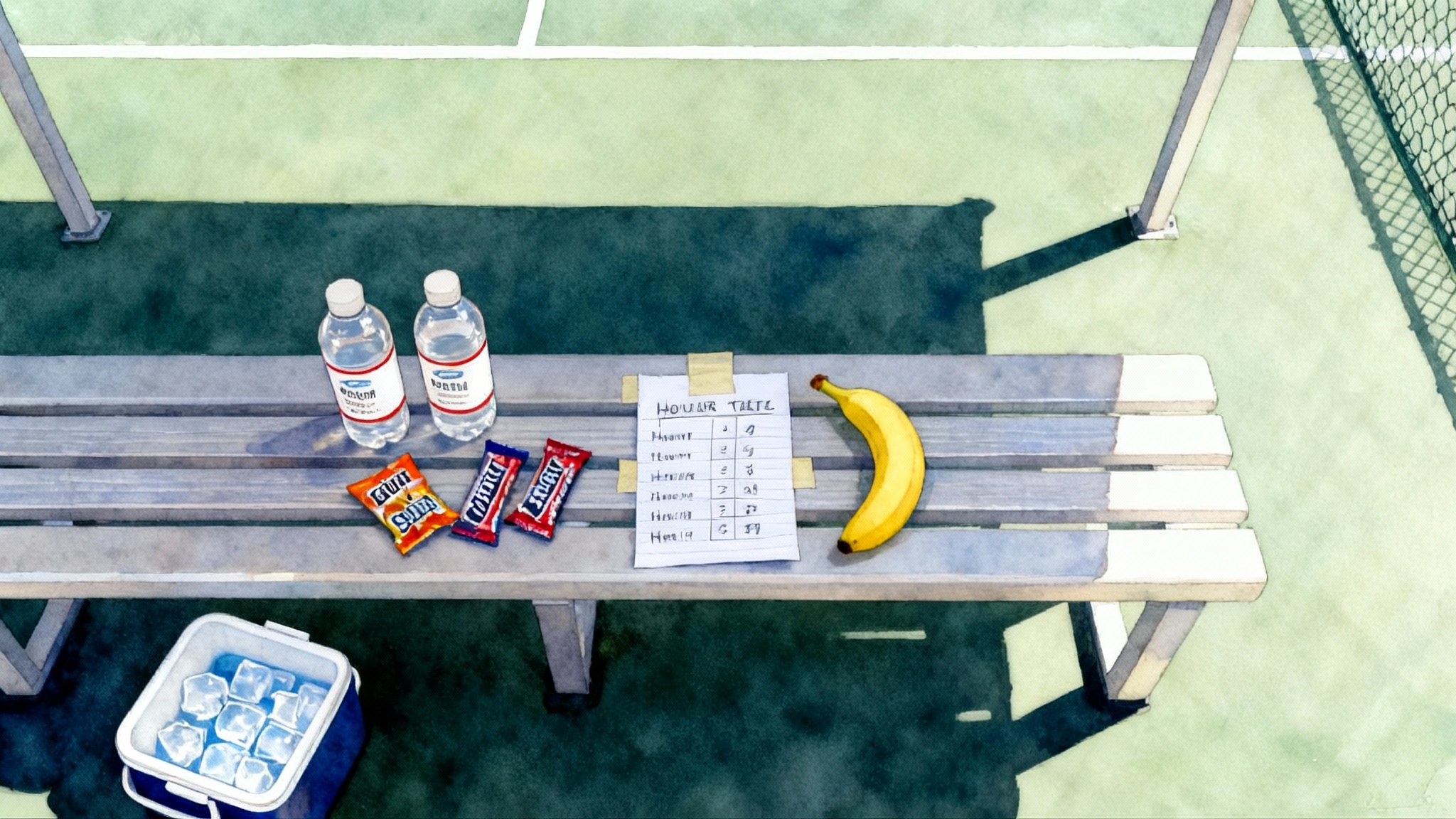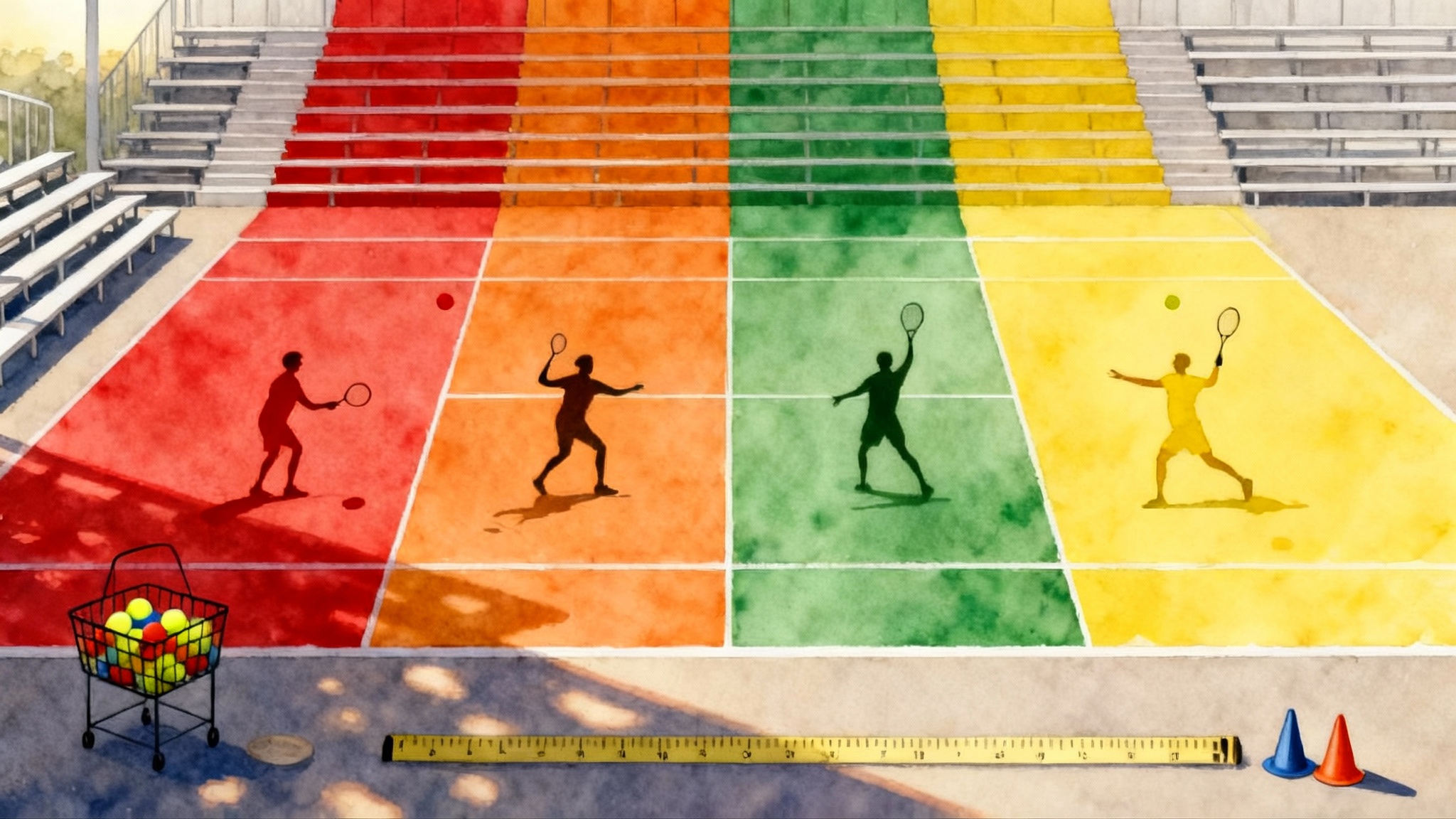Growth-Spurt-Smart Tennis: Managing PHV for Ages 10 to 16
A practical guide to spot growth-spurt windows and adapt court time, footwork, serve and jump loads, and strength work for players ages 10 to 16. Includes at-home PHV screening, red flags, sample weeks, and a coach–parent checklist.
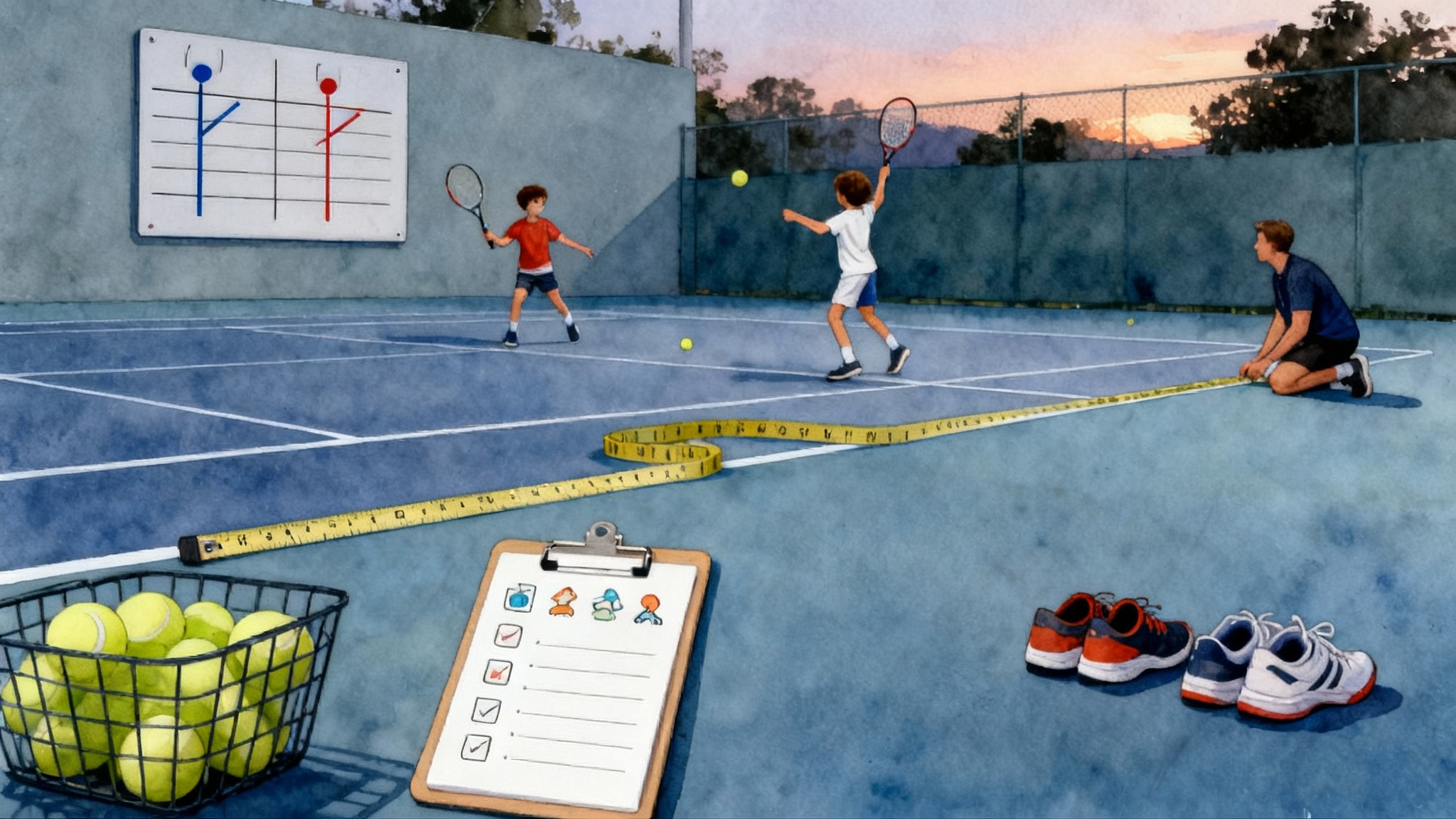
Why growth-spurt-smart tennis matters
If you coach or parent a junior player, you already know that the middle school and early high school years can feel like a moving target. One month a player glides across the baseline, the next month they look like someone quietly swapped their legs overnight. That awkward stage is not clumsiness. It is biology, and it has a name: Peak Height Velocity. Managing it well reduces overuse injuries while keeping skills on track.
This guide explains Peak Height Velocity in plain language, shows you how to spot growth windows at home, lists body-region red flags, and gives practical week-by-week adjustments for training and tournament blocks. It finishes with a simple communication checklist and how two leading programs, GAC High-Performance in Norcross and Emilio Sánchez Academy in Barcelona, integrate PHV monitoring and offer baseline assessments for families.
PHV, explained in one page
Peak Height Velocity, or PHV, is the period when a child grows at the fastest rate during adolescence. Think of growth as a roller coaster. It climbs slowly, surges to a crest, then eases. PHV is the crest. For many girls this arrives around 11 to 12 years, and for many boys around 13 to 14 years, though there is wide normal variation.
Why it matters for tennis:
- Bones lengthen first while muscles, tendons, and neural control lag, which is why timing, balance, and coordination can dip.
- The growth plates and tendon attachment sites are more sensitive to repeated load. That raises risk for knee, heel, hip, and back pain if training stays the same.
- The good news: skill learning remains possible, and movement quality can improve when you choose the right drills and volumes.
If you want a more technical method to estimate how far a child is from PHV, researchers developed a field equation using age, height, sitting height, and weight to estimate maturity offset. See the original description of the Mirwald maturity offset equation.
Simple at-home PHV screening any family can do
You do not need a lab. You need a tape measure, a book, a wall, and a calendar. The goal is to spot acceleration in growth so you can adjust load before problems start.
- Track standing height
- Measure in socks against a wall. Place a book flat on the head, mark the wall, then measure to the floor.
- Measure every two weeks. Enter the numbers on a simple chart or spreadsheet.
- Calculate growth velocity: subtract last height from current height, divide by the number of weeks, then multiply by 52 to get centimeters per year.
- Rules of thumb for a growth-alert:
- Boys: velocity consistently above about 7 to 9 centimeters per year suggests approaching or at PHV.
- Girls: velocity consistently above about 6 to 8 centimeters per year suggests approaching or at PHV.
- Add sitting height twice per month
- Sit with back against a wall on a hardcover book. Place another book on the head and measure from seat to book. Rising sitting height indicates trunk growth, which often coincides with the PHV crest.
- Watch quick-change clues
- Shoe size jumps within one to two months.
- Grip gets tighter even without strength training because hands are growing.
- Appetite and sleep go up. Morning stiffness shows up more often.
- Sudden loss of smoothness in footwork or serve rhythm.
- Create a traffic light for decisions
- Green: growth velocity steady and moderate; player feels good. Train normally.
- Yellow: velocity climbing; player reports new tightness or soreness that resolves in 24 hours. Reduce intensity and jumping. Emphasize technique and strength.
- Red: velocity high; soreness lasts more than 48 hours or affects movement. Stop jumps and heavy serving, modify court time, and consider a sport medicine evaluation.
Body-region red flags during growth spurts
Overuse pain in growing athletes often clusters at tendon and growth plate sites. Teach players to identify and report these early. When in doubt, err on the side of load reduction.
- Knees: pain at the bump below the kneecap that worsens with running, split steps, or squats points to Osgood-Schlatter pattern. Pain at the lower pole of the kneecap suggests patellar tendon irritation.
- Heels: pain at the back or bottom of the heel with running and jumping suggests Sever’s pattern. New limping after drills is a red flag.
- Hips: pain at the front of the hip after serves or sprints can indicate hip flexor or growth plate irritation. Lateral hip pain with change of direction may point to gluteal tendon irritation.
- Low back: one-sided pain with extension and rotation in serving or overheads can signal stress to the pars region. Persistent pain needs assessment before returning to heavy serving.
- Shoulders and elbows: serving volume piled on top of rapid growth increases risk of rotator cuff irritation and medial elbow stress.
- Shins and feet: new shin pain on impact or achy arches after longer sessions may reflect bone stress or plantar fascia irritation.
For broader context, see the AAP guidance on overuse injuries.
How to adapt tennis training during PHV
You can protect growing tissues and still develop skill by adjusting four dials: court time, footwork intensity, jump and serve volume, and strength work.
Court time
- Green phase: normal schedule based on age and level.
- Yellow phase: reduce total weekly minutes by about 15 to 25 percent. Keep the quality high with more basket-fed precision and fewer long rally games.
- Red phase: cut total minutes by about 40 to 60 percent. Focus on technical drills that have low impact and high focus. Replace match play with tactical walk-throughs.
Footwork intensity
- Prioritize rhythm, spacing, and deceleration skills over raw speed.
- Use more lateral shuffles and split-step timing and recovery with low bounces rather than repeated maximal sprints.
- Cap high-change-of-direction drills to two days per week in a yellow phase, one day in a red phase.
Jump and serve volume
- Jumps: count landings, not just reps. In yellow phase, limit to about 60 to 80 landings per session, two sessions per week. In red phase, use landing mechanics practice on soft surfaces and step-down drills instead of jumps.
- Serves: in yellow phase, limit to about 60 to 80 total serves in a day, three days per week, with one full rest day between. In red phase, keep to 30 to 40 serves with focus on ball toss, rhythm, and lower-intensity spin work. Use shadow serves and medicine ball patterns that do not stress the back.
Strength and mobility
- Keep strength training in the plan. Remove heavy axial loads and prioritize single-leg control, hip hinge mastery, and trunk endurance.
- Emphasize isometrics for tendons: split squat holds, calf holds, wall sits, and Copenhagen side planks. Start with 3 sets of 20 to 30 seconds.
- Mobility focus areas: calves, quadriceps, hip flexors, thoracic spine. Use controlled dynamic stretches in warm-ups and short static holds after sessions.
- Technique over load: add weight only when the movement looks the same on the fifth rep as on the first.
Recovery basics that make a real difference
- Sleep: target 9 to 10 hours for this age range. Protect at least 30 minutes of wind-down time before bed.
- Nutrition: include protein at each meal, fruits and vegetables for micronutrients, and regular hydration. During tournaments, add a simple carbohydrate source between matches.
- Footwear: growing feet change fit fast. If heel or knee pain shows up, check for worn midsoles and replace shoes as needed.
Sample weeks: training block vs tournament block
Below are two sample templates you can copy and adjust. The idea is to front-load quality, control the spikes, and keep communication open.
Training block week during a yellow PHV phase
- Monday
- On-court: 75 minutes technical baseline work with basket feeds. Emphasize spacing, open-stance forehands, and neutral stance backhands.
- Strength: 25 minutes technique circuit. Split squat holds, hip hinge practice with dowel, mini-band lateral walks, plank variations.
- Mobility: 10 minutes calves and hip flexors.
- Tuesday
- On-court: 60 minutes serve and return. Cap serves at 70. Add 15 minutes of return footwork without hitting.
- Conditioning: 15 minutes low-impact tempo running or bike. No maximal sprints.
- Wednesday
- Active recovery: 30 to 40 minutes. Easy hit or wall practice, plus mobility and a short walk.
- Thursday
- On-court: 75 minutes pattern play at moderate intensity. Two sets of first-strike patterns to both corners with controlled pace.
- Strength: 20 minutes isometrics. Wall sits, calf holds, Copenhagen plank levels.
- Friday
- On-court: 60 minutes doubles skills. Net approaches and transition footwork at submaximal speed.
- Saturday
- Match play: Two short sets or one timed set. Emphasize tactical goals. Stop if pain changes movement.
- Sunday
- Full rest or light mobility only.
Tournament block week during a yellow PHV phase
- Monday
- On-court: 45 to 60 minutes skills tune-up. Cap serves at 50. No jump-specific drills.
- Mobility: 10 minutes, total body.
- Tuesday
- Light hit: 45 minutes. Emphasize rhythm and ball tracking.
- Wednesday to Friday
- During matches: warm up with movement prep and dynamic flexibility. Between matches, prioritize hydration and a short walk. No extra conditioning.
- Daily cap: if you play two matches, skip any extra hitting. If you play one short match, a 20-minute touch session is fine.
- Saturday
- If still competing: same plan. If out, do 30 minutes light hit and 15 minutes mobility.
- Sunday
- Rest day. Review notes and plan the next week.
Red phase modifications
- Remove all jump-focused drills.
- Keep total weekly on-court time under about 60 percent of normal.
- Replace live points with tactical walk-throughs, hand feeds, and shadow movement.
- Shift strength to technique, isometrics, and tempo work with long rests.
- If pain persists more than 48 hours, or if movement looks guarded, arrange a sport medicine evaluation before resuming heavy loads.
Skill development you should not pause
Even at PHV, certain skills adapt well because they emphasize precision and perception rather than force.
- Ball tracking and reading cues. Use live cooperative rallies with controlled pace and depth targets.
- Contact point consistency. Mark targets and practice hitting through contact at medium speed.
- Serve rhythm. Shadow with a metronome count. Practice toss quality and knee bend timing without forceful jump.
- Tactical decision making. Run point-pattern rehearsals and situational games with easier feeds.
A simple coach-parent communication checklist
Use this checklist on Sunday evenings or before a new block. Keep it short, specific, and written.
- Growth snapshot: standing and sitting height numbers and calculated velocity. Note any shoe size change.
- Pain and soreness log: what hurts, when it started, what makes it worse, what helps. Include morning stiffness.
- Training calendar: which days are technical, footwork emphasis, serve focus, strength, or match play. Identify yellow or red days in advance.
- Volume caps: the actual numbers for the week. Serves, jump landings, on-court minutes.
- Recovery plan: sleep target, nutrition focus, mobility plan, and any school stressors.
- Green light criteria: what has to be true to return to normal load. For example, pain free for 48 hours, full range of motion, and clean movement on three key drills.
- Stop rules: if a body-region red flag appears, who gets notified and what changes that day.
- Next check-in: the date and who is responsible.
How GAC High-Performance and Emilio Sánchez Academy integrate PHV
GAC High-Performance in Norcross and Emilio Sánchez Academy in Barcelona work from the same principle: development first, with smart load management during growth. Here is how families typically experience PHV integration at these programs.
- Baseline assessment you can book: both programs offer an entry session that includes standing and sitting height, arm span, a movement screen for single-leg balance and landing mechanics, strength endurance benchmarks, and a serve mechanics review. Families leave with a simple growth and training chart and the first set of volume caps.
- Ongoing monitoring: players update standing height at least monthly during steady periods and every two weeks when growth accelerates. Coaches note growth velocity inside the player’s training profile and adjust targets.
- Practice design: when a player enters a yellow phase, coaches swap high-impact footwork sets for rhythm and deceleration drills, shift some skill work to basket feeds, and trim match play to avoid spikes. In a red phase, they temporarily remove jump-focused plyometrics and cap serve numbers while emphasizing technical priorities.
- Parent touch points: short, scheduled updates confirm the plan, the numbers, and the stop rules for that week. Parents know the expected feel of each day and what to log.
- Return to full load plan: after a calm week with normal movement and no lingering soreness, coaches step volumes up in two or three small increments rather than a single jump.
Programs that work this way deliver two outcomes that matter. First, fewer nagging injuries that derail seasons. Second, players who build movement quality and self-awareness right when their bodies are changing the fastest.
Your PHV toolkit in one list
- Measure standing height every two weeks. Add sitting height twice per month.
- Track growth velocity on a simple chart and use green, yellow, and red decisions.
- Learn the body-region red flags and act early.
- Adjust the four dials: court time, footwork intensity, jump and serve volume, and strength work.
- Keep developing skills that rely on precision and perception.
- Use a written coach-parent checklist every week.
- Book a baseline assessment so your plan has real numbers.
A clear path forward
This stage is a window, not a wall. With simple home measurements, clear communication, and targeted adjustments, players can protect growing tissues and still improve the skills that separate levels. If you support a 12-year-old learning to love the game or a 15-year-old chasing varsity and national events, a growth-spurt-smart plan will help you do both. Start by measuring, set the week’s caps, and keep the conversation going. That is how you steer through the crest of PHV and come out smoother, stronger, and ready for the next stage.
